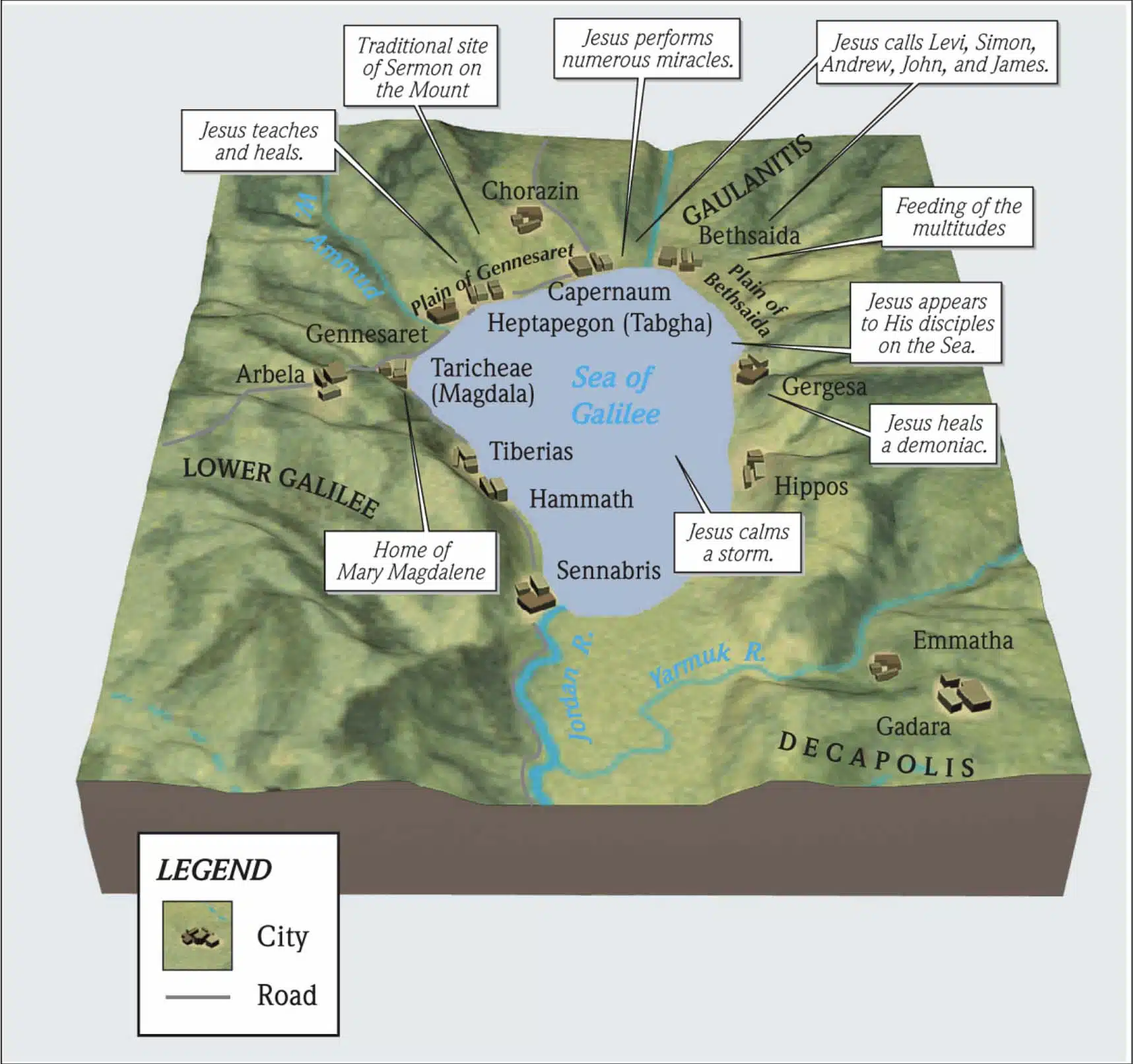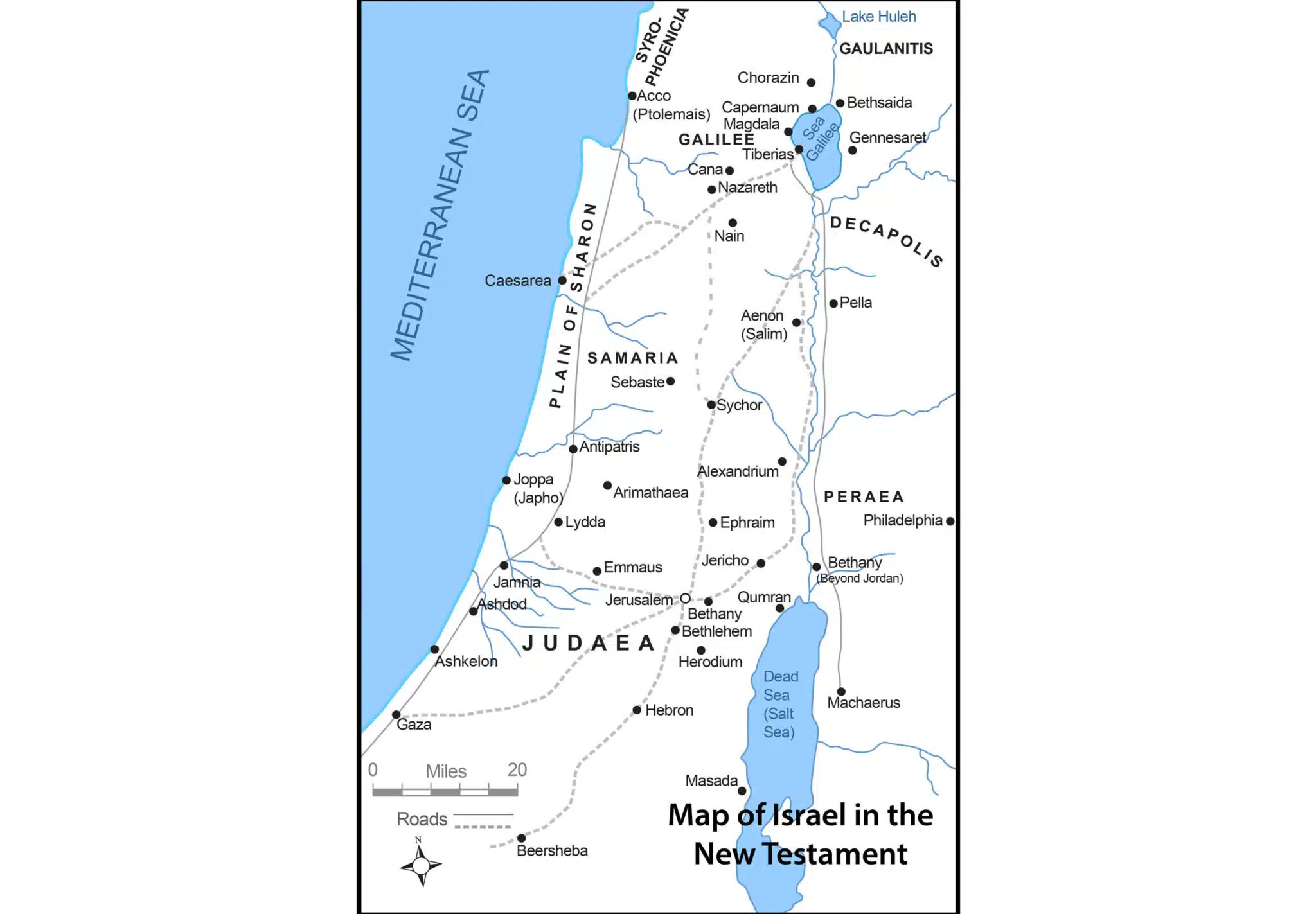The Sadducees ask Jesus a loaded question about the resurrection. They introduce their question with an extreme scenario about a woman seven-times married. Their scenario was intended to show the ridiculousness of the resurrection.
The parallel gospel accounts of this event are found in Mark 12:18-23 and Luke 20:27-33.
Matthew continues his narration of Jesus’s confrontations with the religious authorities in Jerusalem. Jesus had been speaking parables about them that contrasted their wickedness with the goodness of God (Matthew 21:45; 22:1).
Earlier that day Pharisees sent their disciples as spies pretending to be curious supporters of Jesus to trap Him in what He said (Matthew 22:15-16). They shrewdly asked Him if it was lawful to pay the poll-tax to Caesar (Matthew 22:17). Pro-Roman Herodians were also planted with the spies to confirm any charges. But Jesus saw through their deception, and to their amazement answered them: “render to Caesar the things that are Caesar’s; and to God the things that are God’s” (Matthew 22:21).
On that same day, Matthew recorded, some Sadducees came to Jesus questioning Him. The Sadducees were the religious party that controlled the temple. They were rivals, and different from the religious party of the Pharisees in several ways. They performed sacrifices in the temple and were centered in Jerusalem while the Pharisees were dispersed throughout Judea in the local synagogues as teachers of God’s law and the Jewish customs. Another key difference between the Sadducees and Pharisees is that the Sadducees rejected the doctrine of the resurrection from the dead. Matthew highlights this fact when he parenthetically inserts about the Sadducees, who say there is no resurrection.
Additional doctrinal distinctions between these two groups were pointed out by Luke when he reported Paul’s trial before the Council of Jewish authorities:
“As he said this, there occurred a dissension between the Pharisees and Sadducees, and the assembly was divided. For the Sadducees say that there is no resurrection, nor an angel, nor a spirit, but the Pharisees acknowledge them all.”
(Acts 23:7-8)
It is thought that the Sadducees only accepted the first five books of the Old Testament (the books of Moses) as canon. The first century Jewish historian, Josephus, understood this to be the case, “[The Sadducees] admit no observance at all apart from the laws [of Moses]” (Antiquities 18:16). The doctrine of the resurrection is not fully explained in the books of Moses, but as we will see in the next section of commentary it is mentioned (Matthew 22:29-33). The resurrection was more fully taught in other scriptures of the Old Testament that the Sadducees discounted. These scriptures include: Job 19:25-27; Psalm 49:15; Isaiah 25:8; 26:19; Ezekiel 37:12-14; Daniel 12:1-4; and Hosea 13:4.
With the benefit of hindsight, we can see much irony in the fact that the Sadducees, who say there is no resurrection, are asking Jesus (who is Himself“the Resurrection”—John 11:25), about the resurrection.
The Sadducees’ line of questioning that day pertained to the doctrine of resurrection. It has the hallmarks of being a stock “gotcha-question” that is logically unanswerable. It is the kind of question that if the person being asked does not already agree with the question, they will have a difficult time answering. It is a question designed to validate the question’s premise.
The Sadducees feigned respect for Jesus, addressing Him as Teacher. Next, they cited Moses for support. To a Jew, Moses, was the greatest human authority on God’s law. The Jews believed Moses wrote Genesis, Exodus, Leviticus, Numbers, and Deuteronomy, the first five books of the Bible. Moses was the prophet who ascended Mount Sinai in the wilderness and received the Ten Commandments and other instructions directly from God (Exodus 19:18-31:18).
It was proper for the Sadducees to stand upon what Moses said, but they twisted his meaning to an implication that hardly resembled what the law actually said. They cited a law that had nothing to do with the resurrection. What they referenced concerned marriage and family: ‘IF A MAN DIES HAVING NO CHILDREN, HIS BROTHER AS NEXT OF KIN SHALL MARRY HIS WIFE, AND RAISE UP CHILDREN FOR HIS BROTHER.’
This law came from Deuteronomy 25:5 which says, “When brothers live together and one of them dies and has no son, the wife of the deceased shall not be married outside the family to a strange man. Her husband’s brother shall go in to her and taker her to himself as a wife and perform the duty of a husband’s brother to her.” Moses went on to explain how “the first born whom she bears shall assume the name of his dead brother, so that his name will not be blotted out from Israel” (Deuteronomy 25:6).
As stated in Deuteronomy 25:6, the original purposes of this law were to perpetuate the deceased brother’s family as owners of property; continue his namesake; and to provide important protection for young widows who depended upon her husband for support and stability.
But the Sadducees were not interested in the law’s intent. They were trying to poke holes in Jesus’s theology about the resurrection. And they thought that this scripture of Moses, which had nothing to do with the resurrection, could be twisted to that end.
After claiming this passage from Moses as their support, the Sadducees pulled out an elaborate ready-made, extreme example to set up their question. Now there were seven brothers with us; and the first married and died, and having no children left his wife to his brother; so also the second, and the third, down to the seventh. Last of all, the woman died. In their inflated hypothetical scenario, they described a childless woman who was seven times widowed to seven brothers in the same family.
They then ask Jesus: In the resurrection, therefore, whose wife of the seven will she be? Mark and Luke’s account records a clearer and more detailed version of the Sadducees’ question. They record: “In the resurrection when they rise again, which one’s wife will she be?” (Mark 12:23, Luke 20:33). And to ensure that Jesus did not miss their point, the Sadducees reminded Him: For they all had married her.
In asking Jesus this line of questioning, the Sadducees were trying to make Jesus look foolish (and themselves wise), while also taking a shot at their religious rivals the Pharisees, who believed in the doctrine of the resurrection. By challenging Jesus with their preconstructed, hypothetical and extreme, logically-loaded, gotcha-question the Sadducees likely believed that they had effectively trapped Jesus.
They had not.
Biblical Text
23 On that day some Sadducees (who say there is no resurrection) came to Jesus and questioned Him, 24 asking, “Teacher, Moses said, ‘If a man dies having no children, his brother as next of kin shall marry his wife, and raise up children for his brother.’ 25 Now there were seven brothers with us; and the first married and died, and having no children left his wife to his brother; 26 so also the second, and the third, down to the seventh. 27 Last of all, the woman died. 28 In the resurrection, therefore, whose wife of the seven will she be? For they all had married her.”
Check out our other commentaries:
-
Colossians 3:12-15 meaning
Paul gives some examples of what it means to think and act according to the things above. And what binds them all together....... -
Genesis 24:55-61 meaning
Laban and his mother ask the servant to let Rebekah stay in Haran for another ten days before leaving, but the servant does not want...... -
Joel 1:1 meaning
The prophet Joel receives a revelation from God for the people of Judah....... -
Romans 12:14-16 meaning
Living harmoniously by faith in God looks like blessing our enemies. It looks like sympathizing with other people, in good times and bad times. It...... -
Hebrews 11:1-2 meaning
The Pauline Author begins by explaining what faith is. ......




